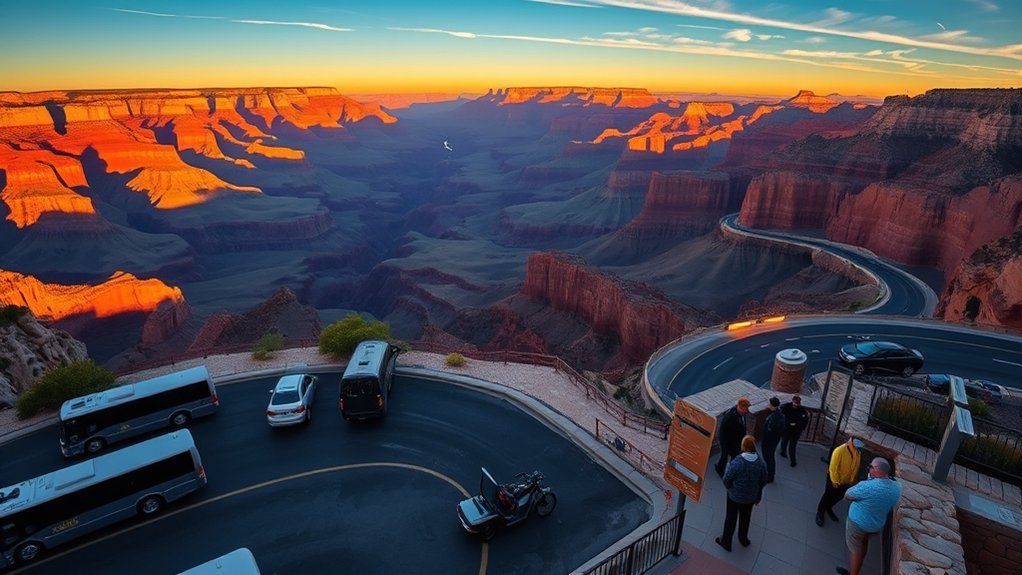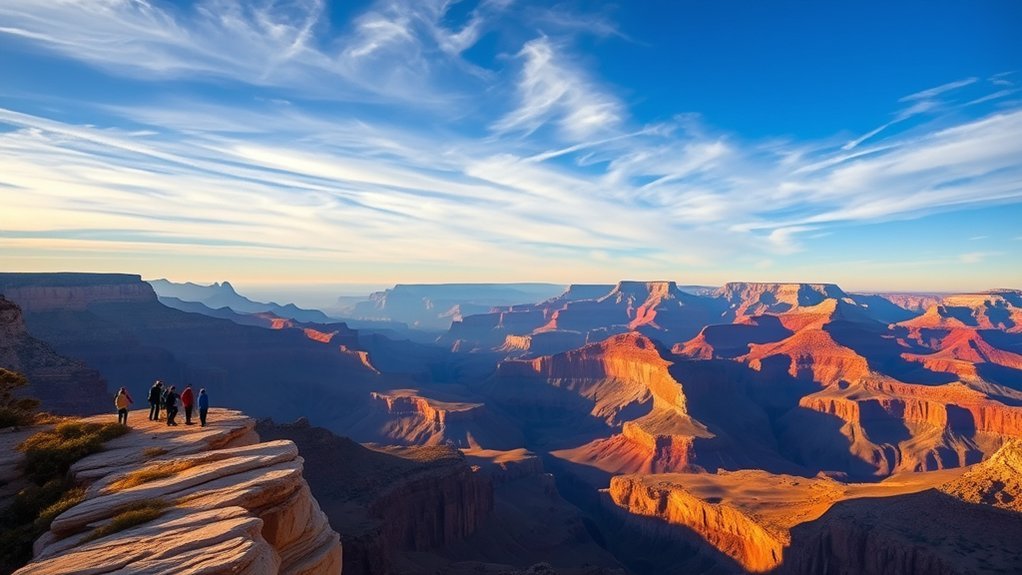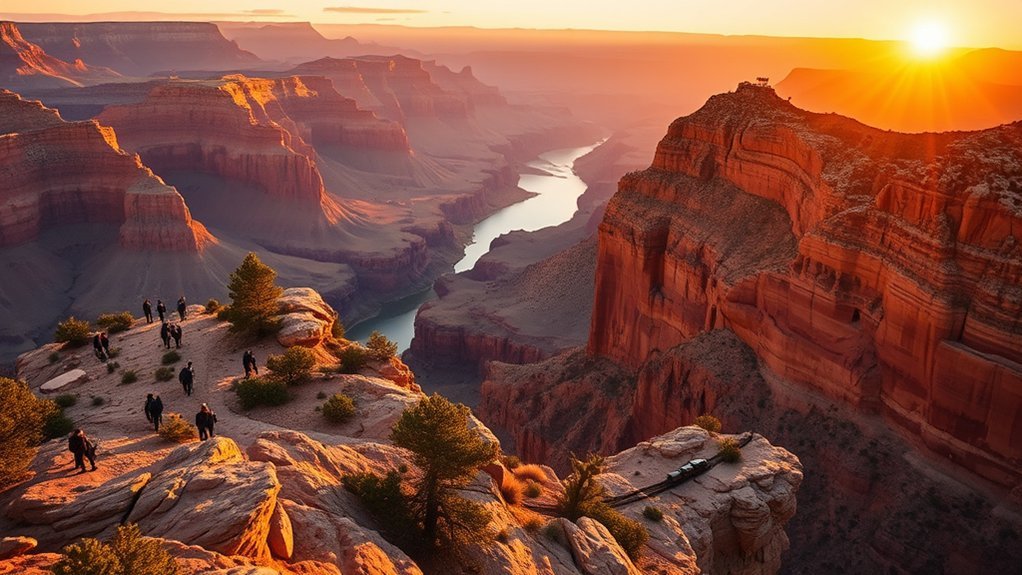Like standing at the edge of an old map, you’ll find yourself planning routes, timing, and gear for the South Rim. You’ll learn practical routes from Flagstaff, Phoenix, and Las Vegas, when crowds swell, which viewpoints are must-see, and how to secure lodging, permits, or shuttle options. I’ll also cover safety, seasonal tips, and trail strategies so you can explore confidently—keep going for clear, usable guidance.
Getting to the South Rim: Routes, Distances & Transportation

Getting to the South Rim is straightforward whether you’re driving, taking the train, or flying in: it’s about 80 miles (roughly 1.5 hours) northwest of Flagstaff, 230 miles (≈3.5 hours) from Phoenix, and 278 miles (≈4–4.5 hours) from Las Vegas by car. You’ll most commonly enter via the South Entrance near Tusayan, where the park charges a $35 parking/vehicle fee (valid seven days) or you can use the America the Beautiful pass. If you’d rather avoid driving, catch the Grand Canyon Railway from Williams; it runs year‑round with a three‑hour turnaround at the South Rim and drops you near Grand Canyon Village. Once inside, use the free shuttle buses and the paved 13‑mile Rim Trail to reach overlooks and trailheads without a car. For air travelers, Las Vegas and Phoenix are the closest international airports, and Papillon and others operate helicopter tours, with options from Las Vegas or the South Rim terminal if you want an aerial perspective.
Best Time to Visit: Seasons, Crowds & Weather Tips

Although the South Rim is open year‑round, when you go will strongly shape your experience: spring and fall offer the most comfortable daytime temperatures and thinner crowds, summer brings peak visitation, heat and monsoon storms, and winter delivers quiet, snow‑dusted views with icy trails. Plan by season: Spring (50–70°F days, cold nights, occasional snow), Summer (hot, crowded, monsoons — start hikes early, carry extra water), Fall (cool days, fewer crowds), Winter (quiet, icy trails—use microspikes).
| Season | Typical Conditions | Visitor Tips |
|---|---|---|
| Spring | Mild days, cold nights | Layered clothing; moderate crowds |
| Summer | Very hot, storms | Early hikes, lots of water; shuttle service helps |
| Winter | Snow, icy trails | Microspikes advised; very few crowds |
Prioritize hiking safety: check seasonal weather, use layered clothing for 30–40°F swings, ride the free shuttle service to avoid parking congestion, and avoid peak summer weekends for a better visit.
Top Things to Do: Viewpoints, Trails, Museums & Activities

When you arrive at the South Rim, prioritize a mix of rim viewpoints, a short or a below‑rim hike, and at least one interpretive stop so you get panoramic views, canyon depth, and the geology that explains it all. At the Grand Canyon South Rim, start with Mather Point for sunrise photos, then walk sections of the paved Rim Trail to sample overlooks and interpretive panels—no steep climbs required. For below‑rim perspective, hike Bright Angel Trail to Plateau Point (longer, water-aware) or choose the shorter, steeper South Kaibab Trail to Skeleton Point for dramatic vistas. Visit the Yavapai Museum of Geology and follow the Trail of Time to understand the canyon’s layered story up close. Drive or shuttle to Desert View Watchtower for expansive panoramas and cultural interpretation. Add a ranger program, mule rides, or guided tours—including air tours from nearby terminals—to deepen your experience and access unique viewpoints and below‑rim options with expert guidance.
Planning Your Stay: Lodging, Camping, Permits & Fees
Because the South Rim sees heavy demand year-round, you should plan lodging, camping, permits and fees well before your trip to avoid disappointment. At Grand Canyon National Park the developed lodging options—El Tovar, Bright Angel Lodge, Kachina, Maswik, Thunderbird and Yavapai—fill quickly, especially in summer, so book as early as possible. If you prefer camping, Mather Campground (327 sites) and Trailer Village RV Park (123 sites, ~80 with full hookups) operate year‑round; Desert View Campground opens seasonally April–October.
Park entrance is $35 per vehicle (or $30 motorcycle, $20 per person on foot/bike), valid seven days; the America the Beautiful pass covers entrance. If you plan to go below the rim, secure backcountry permits early—applications cost $10 plus $8 per person/night below the rim; fees differ above rim. Phantom Ranch lodging and popular backcountry slots use a lottery system entered 13 months ahead, so apply early if you want canyon‑floor accommodations or Bright Angel Campground stays.
Safety, Gear & Practical Tips for Hiking the Canyon
Booking lodging, permits and campsites gets you to the rim—what happens next determines whether your hike is safe and enjoyable. For Grand Canyon hiking, plan for a 20–40°F difference between rim and floor: bring layered clothing and expect much hotter conditions below. Carry 2–4+ liters per person for proper water hydration; don’t rely on unreliable springs without filters and knowledge.
Wear sturdy trail shoes, a wide-brim hat, sunscreen and UV sunglasses. Use the shuttle system or set conservative times; follow the classic turn-around rule—start back when you’ve used half your descent time. Carry a headlamp & first-aid kit, keep a map offline, and know cell service is unreliable. In winter, pack microspikes (winter) and warm layers for rim mornings. Heat risk is real—avoid midday descents, pace yourself, and notify someone of plans. These essentials keep you safe, comfortable and in control on canyon trails.
| Item | Why it matters |
|---|---|
| Water hydration | Prevents heat illness |
| Layered clothing | Handles temp shifts |
| Trail shoes | Reduces slips/ankles |
| Headlamp & first-aid | For emergencies |
Frequently Asked Questions
How Much Time Do You Need at the South Rim of the Grand Canyon?
You need at least a couple hours for highlights, a half‑day for a short hike, a full day for museums and longer trails, an overnight for sunrise/sunset and big hikes, and several days for rim‑to‑rim or backcountry.
Why Is 90% of the Grand Canyon Closed Off?
To protect fragile landscapes, cultural sites, and safety, you’ll find about 90% closed: imagine silent, rugged cliffs and hidden ecosystems preserved from roads, crowds, and development, so wildlife, tribes, and geology stay intact and safe.
Is a Guided Tour of the Grand Canyon Worth It?
Yes — if you want expert context, safety, and efficient access to highlights or special experiences, a guided tour’s worth it; you’ll save planning time and see more, though self-guiding suits budget and solitude seekers.
What Is One Danger Tourists Should Be Aware of When Visiting the Canyon?
Dehydration is a silent thief in the canyon—you’ll lose lots of water fast. Carry at least three liters for short hikes, drink regularly, pace yourself, and watch for dizziness, cramps, or excessive fatigue.
Conclusion
You’ve got the essentials to plan a safe, memorable visit to the South Rim—when to go, how to get there, where to stay, and what to do. Don’t buy the myth that you must hike to the bottom to truly experience the canyon; many iconic views and ranger programs deliver awe without extreme exertion. Use the tips here, respect weather and elevation, and you’ll enjoy the Grand Canyon responsibly and confidently.

